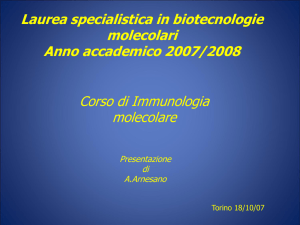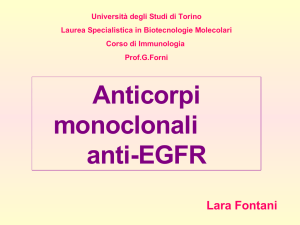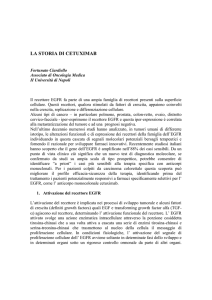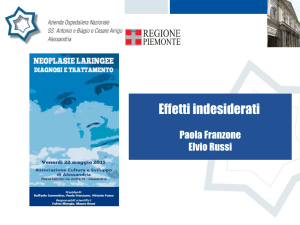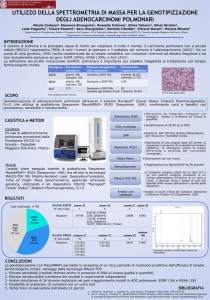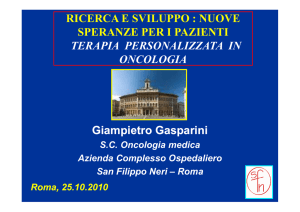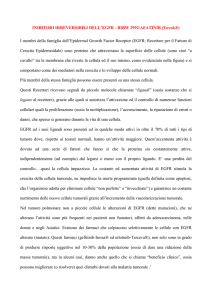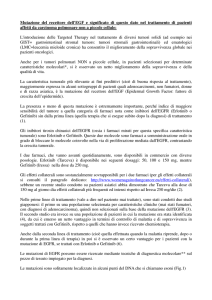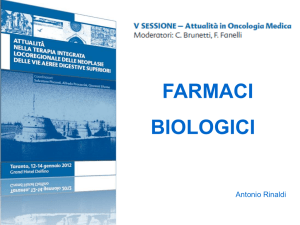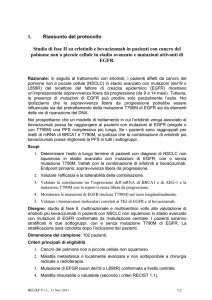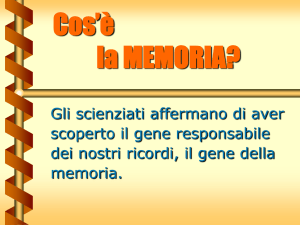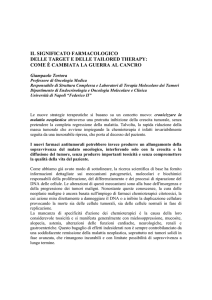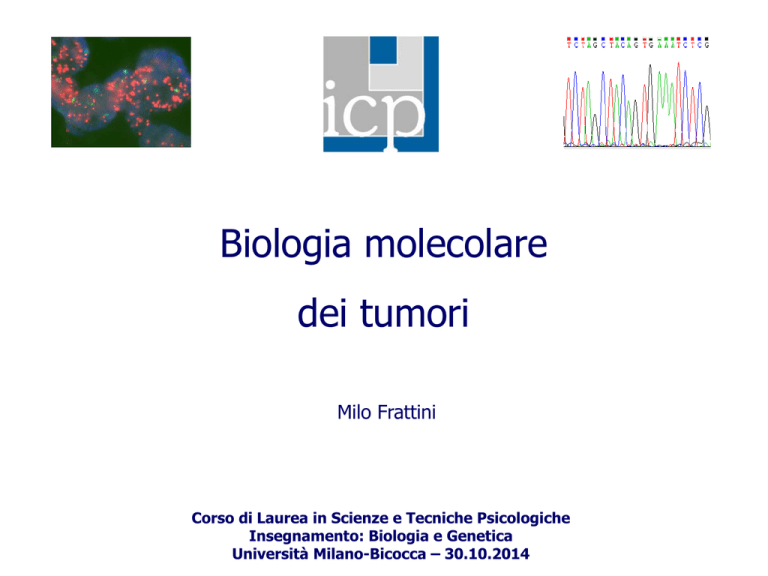
Biologia molecolare
dei tumori
Milo Frattini
Corso di Laurea in Scienze e Tecniche Psicologiche
Insegnamento: Biologia e Genetica
Università Milano-Bicocca – 30.10.2014
Fenotipo - Genotipo
Fenotipo: l’aspetto o altre caratteristiche di un
organismo che risultano dall’interazione
tra la sua costituzione genetica e l’ambiente
Genotipo: l’insieme delle caratteristiche genetiche
(trasmissibili alla progenie) che concorrono
alla determinazione del fenotipo
Alleli
Segregazione degli alleli: gli alleli non si influenzano
gli uni con gli altri ma segregano immutati passando
in gameti diversi
Omozigote: individuo con entrambi gli alleli identici
Eterozigote: individuo con gli alleli diversi
Dominante - Recessivo
Allele dominante: determina il fenotipo di un individuo
eterozigote
Allele recessivo: è oscurato nel fenotipo di un eterozigote
dall’allele dominante, spesso a causa dell’inattività o
dell’assenza del prodotto dell’allele recessivo
Nelle cellule eucariote, come quelle umane, il DNA, che
contiene l’informazione necessaria per dirigere tutte le
attività metaboliche specifiche della cellula, si trova nel
nucleo
NUCLEO
CITOPLASMA
La sede, invece, delle attività metaboliche cellulari è il
citoplasma
E’ stato dimostrato che la sequenza di basi del DNA determina
la sequenza di amminoacidi di una proteina
Struttura di un gene
promotore
“a monte”
Unità di trascrizione
terminatore
“a valle”
La regolazione dell’espressione genica
avviene a numerosi livelli
L’azione biologica delle varie proteine e la loro specificità risiedono
nella loro struttura primaria, da cui dipendono le strutture
secondaria e terziaria
La sostituzione di un solo amminoacido altera profondamente l’azione
biologica di una proteina
Una qualunque modificazione della corretta sequenza di basi nel DNA
può produrre la sostituzione di un amminoacido nella sequenza
caratteristica della proteina
Danni al DNA
• Cambiamenti di una singola base
• Distorsioni strutturali
Mutazioni
Per mutazione si intende un qualsiasi cambiamento nella
sequenza di DNA di un genoma
• Mutazione puntiforme: è un cambiamento che riguarda
solo una coppia di basi di un gene
• Riarrangiamento: può interessare un ‘ampia regione.
Le forme più semplici sono le inserzioni e le delezioni,
quelle più complesse le traslocazioni
Mutazioni puntiformi
Transizioni:
sostituzione di una purina con un’altra o
di una pirimidina con un’altra.
Es: G:C→A:T
Transversioni: sostituzione di una purina con una
pirimidina o viceversa.
Es: G:C→T:A
Mutazioni puntiformi
Una mutazione puntiforme che non cambia un codone e
quindi non ha effetti sulla sequenza aminoacidica è
chiamata mutazione silente
Mutazioni puntiformi
Una mutazione puntiforme che cambia un codone in modo
tale che questo rappresenti un aminoacido differente è
chiamata mutazione missenso
Mutazioni puntiformi
Una mutazione puntiforme che cambia un codone in modo
tale che questo rappresenti uno dei tre codoni di
terminazione è chiamata mutazione non-senso
Riarrangiamento
Le delezioni sono generate dalla rimozione di una
sequenza di DNA e dalla saldatura delle regioni adiacenti
Le inserzioni sono generate dall’aggiunta di uno o più
nucleotidi
Le traslocazioni sono invece riarrangiamenti in cui una
parte di un cromosoma è staccata per rottura e poi
riattaccata su un altro cromosoma
Effetto delle mutazioni
Mechanism of chromosome
rearrangement (1)
Chromosome breaks
are caused by ionizing
radiation, for example
X-rays and g-rays
Broken DNA ends must
be repaired
Mechanism of chromosome
rearrangement (2)
Crossing over between short
repeated sequences can also
lead to various chromosome
rearrangements
Two mechanisms to generate
chromosome rearrangements:
breakage and crossing-over
Gene amplification
Gene Mutation
Normal Gene
Chromosome re-arrengements
Novel regulatory sequences
Fusion transcripts
Schematic Overview
cell
CELLULA NORMALE:
sequenza di nucleotidi corretta
-A-T -T-A
T
--A-C--- G
cancro
CELLULA TUMORALE:
mutazioni
---C-G -T-A
DNA replication is
semiconservative
Replication is
semiconservative,
with each DNA strand
serving as template
for synthesis of the
complementary strand
Fork movement
This is true for all
eukaryotes, prokaryotes,
viruses and
bacteriophage
Replication
fork
DNA Mutations: An Overview
Esempio di mutazione missenso nel cancro
sequenza normale
sequenza mutata
seq. wild-type
seq. mutata
A
C
T
A
G
C
A
T
T
G
C
A
T
C
G
T
A
T
G
C
A
A
T
G
C
T
A
G
T
T
C
G
T
A
FISH - procedura
FISH - PATHVYSION
cen17
HER2
2 geni vs 2 chr: R=1
nucleo
Chr.17
12 geni vs 2 chr: R=6
cen17
HER2
Chr.17
R2 no amplification
R2
nucleo
amplification
c-myc translocations
Chromosome 14
Chromosome 8
c-myc
Ex 1
Chromosome 14
Chromosome 8
c-myc
Ex 1
Chromosome 8
c-myc
Ex 1
Ex 2
Ex 2
Ex 2
Chromosome 22
Ex 3
Chromosome 8
c-myc
Ex 1
Ex 2
Ex 3
Chromosome 2
Ex 3
Mutazioni somatiche
E’ una mutazione che si verifica in una cellula somatica e
pertanto interessa soltanto i suoi discendenti; non
viene ereditata negli individui delle generazioni successive
Mutazioni germinali
E’ una mutazione che si verifica in una cellula germinale e
pertanto viene ereditata negli individui delle generazioni
successive
Frequenza di mutazione
La frequenza di mutazione negli eucarioti è di circa
10-9 - 10-10 a livello dei singoli nucleotidi
Non tutte le mutazioni portano a cambiamenti
osservabili nel fenotipo
Definizione di cancro
Il cancro e’ una malattia genica, ovvero
insorge in conseguenza dell’accumulo
nella stessa cellula di alterazioni di
geni di diverse categorie
(oncogeni ed oncosoppressori)
ISTITUTO TUMORI MILANO
Definizione delle funzioni dei geni
Positive
regulation
NORMAL
INDUCTION
Activated
oncogenes
MITOTIC
ACTIVITY
INHIBITION
Negative
regulation
ACTIVATION OF ONCOGENES (gain of function)
INDUCTION
MITOTIC
ACTIVITY
INHIBITION
Negative
regulation
Positive
regulation
INDUCTION
MITOTIC
ACTIVITY
BLOCKED
INACTIVATION OF TUMOR SUPPRESSORS (loss of function)
Inactivation
INHIBITION of tumor
suppressor
genes
ISTITUTO TUMORI MILANO
Oncogenes
• Proto-oncogenes generally encode proteins
that regulate normal cell proliferation or
apoptosis
• Normally encode either positive or negative
regulators
• Accumulate mutations to become oncogenes
–
–
–
–
point mutations alter structure/function
loss of protein domains resulting from deletion
gene fusions, often resulting from translocations
sometimes mutation results in misexpression, with
protein expressed in wrong place or time
Definizione di cancro
Nel 5-8% dei casi il cancro e’ anche una
malattia genetica (una prima alterazione
genica e’ presente nella linea
germinale dell’individuo)
ISTITUTO TUMORI MILANO
Esempio di patologia:
il cancro del colon-retto
Cancro colorettale - Epidemiologia
•
Il cancro colorettale è la seconda causa di morte per malattie
neoplastiche.
•
Nei paesi industrializzati, ogni anno si verificano circa 950.000 nuovi casi e
500.000 decessi.
•
Almeno il 50% della popolazione occidentale sviluppa un adenoma a
partire dall’età di 70 anni e nel 10% dei casi degenera in cancro.
•
Piu’ del 95% dei pazienti affetti da cancro colorettale hanno un’età
superiore ai 45 anni al momento della diagnosi.
•
Studi epidemiologici hanno suggerito che almeno il 10% dei cancri sono di
origine ereditaria (es: Familial Adenomatous Polyposis (FAP) in 1 caso ogni
7000 individui; Hereditary Non Polyposis Colorectal Cancer (HNPCC) nel 24% totale dei casi)
•
La maggior parte dei casi è di origine sporadica.
Indicatori prognostici
La stadiazione patologica fornisce le migliori indicazioni
prognostiche :
profondità di invasione
numero di linfonodi metastatici
Dukes
Meyerhardt et al, NEJM 2005;352:476-487
TNM
Progression to cancer
Modelli di progressione del tumore colorettale
APC
APC
Met (p16)
Iper
proliferazione
Adenoma
tipo I
b-catenina
APC
b-catenina
Iper
proliferazione
APC
Met (p16)
K-RAS
Adenoma
tipo II
APC
Met (p16)
K-RAS
DCC
p53
Carcinoma
in situ
Metastasi
TGFbRII, BAX, BRAF
IGF-IIR, E2F4, TCF-4
MMR genes
(MLH1, MSH2, ...)
Adenoma
tipo I
APC
Met (p16)
K-RAS
DCC
Adenoma
tipo II
Carcinoma
in situ
Metastasi
EGFR: mechanism of activation
Ligand
Monomer
Monomer
P
P
Cross-auto
phosphorylation
Dimer
Cell survival
Signaling
pathways
Cell duplication
EGFR downstream pathways
Harari et al, J Clin Oncol 2007;25:4057-4065
EGFR-targeted therapy
Tyrosin Kinase Inhibitors
Erlotinib (Tarceva®)
Gefitinib (Iressa®)
Lapatinib (Tyverb®)
Monoclonal Antibodies
Cetuximab (Erbitux®)
Panitumumab (Vectibix®)
Ciardiello and Tortora, N Engl J Med 2008;358:1160-1174
Esempio di pathway
EGFR
out
cytoplasm
PI3K
PTEN
Akt
K-Ras
BRAF
MEK
mTOR
ERK1,2
nucleus
EGFR-targeted therapy: MoAbs
Cetuximab and Panitumumab recognize the
extracellular domain of EGFR, lead to receptor
internalization and degradation, and therefore
block EGFR and its downstream cascade
activation.
Both drugs are effective only in ~10% of metastatic colorectal
cancer (mCRC) patients when administered as single agent
therapy, and ~ 20-30% when in combination with irinotecan
EGFR protein overexpression by immunohistochemistry is
required before treatment
(Saltz et al, 2004; Cunningham et al, 2004; Van Cutsem, 2007)
EGFR protein expression by IHC
There is no relationship between the level of EGFR expression as
detected by IHC and anti-EGFR MoAbs response.
(Saltz et al, 2004; Cunningham et al, 2004)
25% of EGFR negative (as detected by IHC) patients benefit from
cetuximab.
(Chung et al, 2005)
EGFR evaluation by IHC depends on:
type of fixative used,
storage time of unstained tissue sections
methods of immnohistochemistry analyses and/or evaluation
(Atkins et al, 2004; Langner et al, 2004; Kersting et al, 2006)
EGFR protein expression by IHC
EGFR evaluation by IHC depends on the primary antibody used:
DAKO pharmDx
Zymed (EGFRkit)
Ventana (3C6 AK)
Cut-off level 1%
75%
93%
86%
Cut-off level 5%
61%
80%
78%
Cut-off level 10%
48%
72%
60%
Penault-Llorca et al., Oncol Rep 2006
- IHC does not seem to represent the gold standard method for patient
selection and for anti-EGFR therapy efficacy prediction
EGFR by FISH
normale
normale
Normal status (disomy)
EGFR by FISH
Chromosome 7 polysomy
EGFR gene amplification
CNG (copy number gain)
EGFR by FISH
Stato genico EGFR normale
DISOMIA
CROMOSOMA 7
Aumento numero di copie geniche di EGFR
POLISOMIA
CROMOSOMA 7
BASSA POLISOMIA
LP: ≥ 4 Cr7 in 1040% of cells
AMPLIFICAZIONE
GENICA
ALTA POLISOMIA
HP: ≥ 4 Cr7 in ≥
50% of cells
FISHNon Small Cell Lung Cancer Working Group, Eberhard, Giaccone and Johnson, J Clin Oncol 2008;26:983-994.
R: EGFR/centr Cr7
2 in ≥ 10% of cells
FISH+
EGFR by FISH
3/27 (11%)
Chromosome 7
polysomy
16/27 (59%)
EGFR gene
amplification
8/27 (30%)
PR
0
4
6
NR (PD+SD)
3
12
2
disomy
green = chromosome 7 centromere
red= EGFR gene
1*
19*
* Moroni et al, 2005
- Patients with disomy do not respond
- Patients with chromosome 7 marked polysomy and/or EGFR
gene amplification may benefit from cetuximab treatment
(Frattini et al, Br J Cancer 2007;97:1139-1145)
EGFR by FISH
Cases
Type
FISH interpretation criteria
Number of
cases and
%
Observations
Ooi et al.
2004
244
CRC
Amplification when a definite cluster or more than 10 orange
signals were found.
11/244 (4%)
--
Sauer et
al.Authors
2005
and year
48
Cases
RC
Type
37/48 (77%)
Number
4/48
(8%) of
cases
and
7/48
(15%)
%
-Observations
Ooi et al.
Moroni
2004 et
al. 2005
244
31
CRC
mCRC
11/244 (4%)
9/20 (45%)
Of the 9 patients with CNG 8 responded and
1 non responded-- to cetuximab or
panitumumab, suggesting a genetic basis of
response to anti-EGFR treatment
48
RC
27
mCRC
31
mCRC
58
mCRC
Frattini et
Cappuzzo
al. 2007
et al. 2007
27
85
mCRC
mCRC
SartoreBianchi
Italiano
et
et al 2007
al 2008
58
41
mCRC
mCRC
Cappuzzo
et al. 2007
85
mCRC
Italiano et
al 2008
41
Authors
and year
Sauer et
al. 2005
Frattini et
al. 2007
Moroni et
al. 2005
SartoreBianchi
et al 2007
1) Balanced if 0.8 > R <1.2
2) Copy loss if R < 0.8
3) Copy gain if R ≥FISH
1.2 interpretation criteria
Amplification
when nucleus
a definite
cluster or more than 10 orange
Score EGFR gene/
(CNG).
signals
were
found.
Increased
EGFR
CNG was defined as the presence of three or
more signals per nucleus.
1) Balanced if 0.8 > R <1.2
2)
if R of
< 0.8
1) Copy
Loss ifloss
1 copy
chr 7 in >50% of cells
3)
gain
R ≥ 1.2of chr 7 in >50% of cells
2) Copy
Disomy
if 2ifcopies
3) Low polysomy If 3 or 4 copies of chr 7 in >50% of cells
4) Marked polysomy if >4 copies of chr 7 in >50% of cells
Score EGFR gene/ nucleus (CNG).
5) Amplification if R> 3 in at least 10% of cells
Increased EGFR CNG was defined as the presence of three or
more
nucleus. and use the cut off value.
Scoresignals
EGFR per
gene/nucleus
FISH + if > 2.5 and/or > 40% chr 7 polysomy
1)
Loss
1 copy
of chr
7 in >50%
of cells
FISH
- ifif≤2.5
and/or
≤ 40%
chr 7 polysomy
2) Disomy if 2 copies of chr 7 in >50% of cells
Score
/nucleus
use the
value.
3) LowEGFR
polysomy
If 3 orand
4 copies
ofcut
chroff
7 in
>50% of cells
FISH
+
if
>
2.92
4) Marked polysomy if >4 copies of chr 7 in >50% of cells
FISH
- if ≤ 2.92 if R> 3 in at least 10% of cells
5) Amplification
FISH
Score+:
EGFR gene/nucleus and use the cut off value.
40%+of
cells
4 copies
of the EGFR signals or with
FISH
if >
2.5 displaying
and/or > 40%
chr 7 polysomy
gene
amplification**
FISH - if ≤2.5 and/or ≤ 40% chr 7 polysomy
FISH -:
Score
EGFR
and usethe
cut offofvalue.
<than 40%
of /nucleus
cells displaying
4 copies
the EGFR gene and
FISH
+ ifamplification**
> 2.92
no gene
FISH - if ≤ 2.92
37/48 (77%)
4/48
0/27 (8%)
(0%)
7/48
3/27 (15%)
(11%)
0/27 (0%)
16/27 (59%)
8/27 (30%)
9/20 (45%)
38-39/58
20-19/58
0/27 (0%)
3/27 (11%)
0/27
43/85(0%)
(50%)
16/27
42/85 (59%)
(50%)
8/27 (30%)
38-39/58
20-19/58
8/41 (20%)
33/41 (80%)
-Patients whit amplification
or marked
polysomy have a increased likelihood to
response to cetuximab therapy (depending
Of
theK-ras
9 patients
CNGstatus)
8 responded
from
and with
PTEN
while and
the
1
non oneresponded
cetuximab or
disomic
in generally to
are resistant
panitumumab, suggesting a genetic basis of
Patients
disomic ortreatment
low polisomy of chr7
responsewith
to anti-EGFR
have a reduced likelihood to response to
Patients
whit amplification or marked
panitumumab
polysomy have a increased likelihood to
response
to cetuximab
Patients with
EGFR CNGtherapy
have an(depending
increased
from
K-ras
and PTEN
status) while
the
likelihood
to response
to cetuximab
therapy
disomic one in generally are resistant
Patients with disomic or low polisomy of chr7
have
reduced
to
EGFRagene
copy likelihood
number is to
notresponse
statistically
panitumumab
significantly correlated with clinical benefit
from cetuximab- containing therapy
Patients with EGFR CNG have an increased
likelihood to response to cetuximab therapy
(50%)
EGFR gene status by FISH may43/85
represent
a
42/85
(50%)
FISH
+:
predictive
factor of good response to
40% of cells displaying 4 copies of the EGFR signals or with
EGFR gene copy number is not statistically
8/41 (20%)
gene amplification**
mCRC
significantly correlated with clinical benefit
targeted
therapies
against
EGFR.
33/41 (80%)
FISH -:
from cetuximab- containing therapy
<than 40% of cells displaying 4 copies of the EGFR gene and
no gene amplification**
(Martin et al, 2008 - doi:10.1136/jcp.2008.059592 )
EGFR by FISH
EGFR by FISH
3/27 (11%)
Chromosome 7
polysomy
16/27 (59%)
EGFR gene
amplification
8/27 (30%)
PR
0
4
6
NR (PD+SD)
3
12
2
disomy
green = chromosome 7 centromere
red= EGFR gene
1*
19*
* Moroni et al, 2005
- Patients with disomy do not respond
- Patients with chromosome 7 marked polysomy and/or EGFR
gene amplification may benefit from cetuximab treatment
(Frattini et al, Br J Cancer 2007;97:1139-1145)
EGFR downstream pathways
EGFR
out
cytoplasm
mutated in ~40%
of sporadic CRC
PI3K
PTEN
Akt
KRAS
BRAF
MEK
mTOR
ERK1,2
changes in
gene expression
cell survival
nucleus
angiogenesis
tumor metastasization
cell proliferation
tumor invasion
EGFR downstream pathways
EGFR
out
cytoplasm
mutated in ~40%
of sporadic CRC
X
PI3K
PTEN
Akt
KRAS
X
BRAF
MEK
mTOR
ERK1,2
changes in
gene expression
cell survival
nucleus
angiogenesis
tumor metastasization
cell proliferation
tumor invasion
EGFR downstream pathways
EGFR
out
cytoplasm
mutated in ~40%
of sporadic CRC
mutated in ~20-30%
of sporadic CRC
PI3K
PTEN
Akt
K-Ras
BRAF
mutated in ~5-10%
of sporadic CRC
MEK
mTOR
ERK1,2
changes in
gene expression
cell survival
nucleus
angiogenesis
tumor metastasization
cell proliferation
tumor invasion
EGFR downstream pathways
EGFR
out
cytoplasm
mutated in ~40%
of sporadic CRC
mutated in ~20-30%
of sporadic CRC
PI3K
PTEN
Akt
loss in ~30%
of sporadic CRC
K-Ras
BRAF
mutated in ~5-10%
of sporadic CRC
MEK
mTOR
ERK1,2
changes in
gene expression
cell survival
nucleus
angiogenesis
tumor metastasization
cell proliferation
tumor invasion
K-Ras status and clinical response
K-Ras
Wild-type
Mutant
79/113 (70%)
34/113 (30%)
*
Responders
22/79 (28%)
2/34 (6%)
Non-responders
57/79 (72%)
32/34 (94%)
p<0.05, two-tailed Fisher’s exact test
K-Ras mutations correlate with resistance to anti-EGFR MoAbs
(Di Nicolantonio & Martini & Molinari et al, J Clin Oncol 2008;26:5705-5712)
KRAS status and clinical response
KRAS wt
KRAS mut
(Amado et al, 2008)
KRAS status and clinical response
Panit.
BSC
KRAS mut
(Amado et al, 2008)
KRAS wt
K-Ras mutations: meta-analysis
K-Ras
Wild Type
Mutated
KRAS
Response Rate Response Rate
Study
Patients mutations (%)
(%)
(%)
Moroni et al
31
32
38
20
Di Fiore et al
59
37
32
0
Frattini et al
27
37
53
10
Benvenuti et al
48
33
31
6
mutations
associated
with
cetuximab/panitumumab
resistance
Khambata-Ford et al
80
38
10
0
Karapetis et al
394
42
13
1
Lievre et al
89
27
40
0
and
account
for
about
40%
of
NR
patients
De Roock et al
113
41
41
0
Amado et al
427
43
17
0
Van Cutsem et al
540
36
59
36
Bokemeyer et al
233
42
61
33
Plesec et al, 2009
http://www.fda.gov/AboutFDA/CentersOffices/CDER/ucm172905.htm
K-Ras status and clinical response
K-Ras
Wild-type
Mutant
79/113 (70%)
34/113 (30%)
*
Responders
22/79 (28%)
2/34 (6%)
Non-responders
57/79 (72%)
32/34 (94%)
p<0.05, two-tailed Fisher’s exact test
?!?
K-Ras mutations correlate with resistance to anti-EGFR MoAbs
(Di Nicolantonio & Martini & Molinari et al, J Clin Oncol 2008;26:5705-5712)

